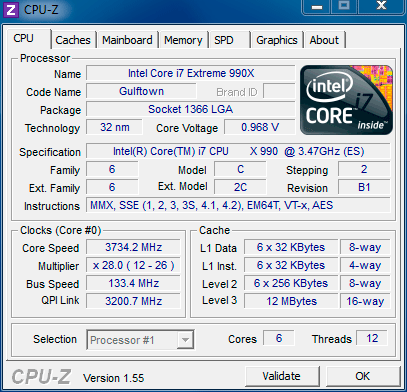Intel Core i7-990X Extreme: Crazy Fast Got Faster
Vital Signs and Overclocking
Intel has taken the LGA1366 socket down a long, profitable road from Nehalem to Gulftown. It's a lot of pins to work with and with the design and manufacturing resources that Intel has at their disposal, it's not surprising this latest LGA1366 derivative offers a ton of headroom too.
CPU-Z shows us what the new 990X is made of. Seen here at it's top-end Turbo Boost speed of 3.73GHz with a 28X multiplier, you'll also note that voltage is being monitored at a svelte .968V (plus or minus a few tenths of a volt). Beyond that we have 12MB of shared L3 cache (1.5MB or 256K per core of L2), a stock reference clock speed of 133MHz and a QPI link speed of 3.2GHz, which translates to 6.4GT/sec of bi-directional bandwidth.


Intel Core i7-990X Overclocked to 4.3GHz, Stock Retail Cooler, 100% Load
|

And of course we decided to check out the available upside potential of the new chip with a bit of elbow grease and overclocking. In reality, the elbow grease required was minimal and with the help of Intel's DX58SO2 motherboard (details on the coming pages), we were able to do some rather magical things with our new Extreme Edition friend.

Intel Core i7-990X Overclocked to 4.3GHz, Stock Retail Cooler, 100% Load
With a simple retail Intel cooler at our disposal, we were able to bump the chip's reference clock to 166MHz, leaving the multiplier set to 28X with Turbo Boost disabled. For good measure we also goosed a few tenths of a volt higher for core voltage to 1.33V. Also, to ensure stability, the QPI link multiplier was dropped, especially since overclocking QPI does nothing for performance. The end result was a peppy 4.3GHz overclock, fully stable under 100% load. We also booted and ran several loops of Cinebench (seen in the background here) at 4.5GHz (170MHz on the ref clock). Unfortunately 4.5GHz wasn't fully stable but perhaps with more exotic cooling and a bit more tinkering that speed would have been attainable as well. Regardless, where we have historically maxed out at 4.1GHz with this sort of basic setup, it appears, over time, that Intel has improved their yield margins significantly with their 6-core Core i7 variant.







